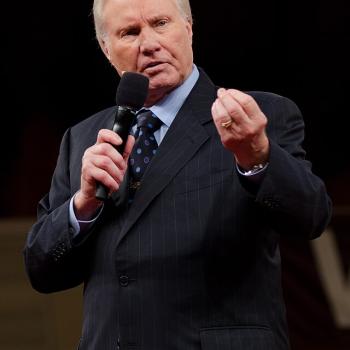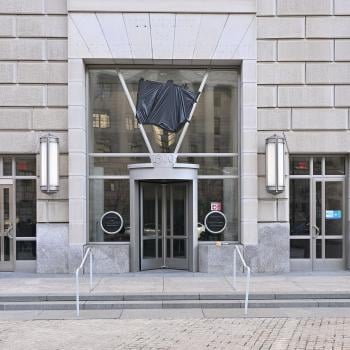I grew up Pentecostal and have now been Baptist for, oh, about forty years. The other day I was talking with students (mostly Baptists) about the doctrine and experience of the “second blessing” that grew out of the ministry of John Wesley. Wesley himself never equated entire sanctification (“Christian perfection”) with Spirit baptism/infilling of the Holy Spirit, but he clearly did believe in a post-conversion experience of sanctification “in a moment” (preceded by a process and followed by a process). His follower John Fletcher developed this into a doctrine of Spirit baptism subsequent to conversion. Throughout the nineteenth century so-called “Holiness” (broadly defined) Christians embraced this and promoted it. In the mid-nineteenth century Phoebe Palmer led holiness meetings in her home in New York City where people who were already converted received the infilling of the Spirit–their own Pentecost, so to speak.
This doctrine (that Spirit baptism or infilling subsequent to conversion) became a hallmark of a certain branch of evangelicalism in the later nineteenth century. Christian leaders as diverse as Charles Finney, R. A. Torrey, A. B. Simpson, and others embraced and promoted it well before Pentecostalism burst on the scene. In fact, one could argue that Pentecostalism ONLY added the doctrine of speaking in tongues as the “initial, physical evidence” of Spirit baptism, the “second blessing.”
Well before Pentecostalism, however, and outside of it, many evangelical Christians have believed in and promoted an experience subsequent to conversion (although most would say it can happen at conversion) the launches one into a “higher” or “deeper” spiritual life marked by supernatural, Spirit-endowed power to overcome sin and engage in service to Christ’s mission. Bill Bright, for example, founder and leader of Campus Crusade for Christ, regularly led participants in his evangelism training events in receiving the infilling of the Holy Spirit–after conversion.
All of these people, including Pentecostals, believe conversion to Christ by faith includes “receiving the Holy Spirit.” They look at the pattern of John and Acts where Jesus breathed on his disciples imparting the Holy Spirit to them, to be in and with them, and then told them to go to Jerusalem and wait for the enduement with power that would make them witnesses to the ends of the earth.
Many evangelical (and other) New Testaments scholars and theologians criticize this “two stage” Christian initiation. One main argument they use is that Scripture teaches “one Lord, one faith, one baptism.” But believers in subsequence do not deny that. They regard the “one baptism” as referring to water baptism. The basis for calling subsequent Spirit infilling “Spirit baptism” lies in Jesus’ promise that John baptized people with water but he, Jesus, would baptize them the Holy Spirit and fire (power).
I think a lot of the controversy has been caught in wrangles about terminology. To the best of my knowledge, most scholarly believers in subsequence of the fullness of the Spirit to conversion do not particularly care what it’s called. “Infilling of the Spirit,” “enduement with power,” are valid alternatives to “Baptism of the Holy Spirit.”
Appealing to experience, but connecting it with the pattern of Acts, I believe in subsequence of receiving the Holy Spirit in a new and special way–call it what you will. I observe that many, many evangelical Christians struggle to live Christian lives without joy, liberty, or power. Their attitude betrays that being a follower of Jesus Christ is a duty rather than a pleasure. Then I have often observed (and experienced) a quantum leap beyond that into passionate, joyful, inwardly committed, powerful Christian life following a special, personal outpouring of the Spirit–usually upon laying on of hands by Christians who live in that higher or deeper life of the Spirit.
Two things led me to reject tongues as the sine qua non of this subsequent experience of the Spirit’s infilling. First, I could not find that clearly, unequivocally taught in Scripture. Second, I saw many, many avid tongues-speakers lacking joy, power, liberty and all the things that Spirit infilling should produce.
I also came to believe that there is no “once-for-all” infilling of the Spirit. Being filled with the Spirit is not a one-time experience but a “punctuated process” (to borrow from and paraphrase my late friend and mentor Clark Pinnock). There is always more. And it is possible to lose the Spirit’s infilling and be filled again.
John Piper clearly believes in what I am describing here. See his 1990 sermon “You Will Be Baptized with the Holy Spirit”–easily found on the internet using a search engine.
I tell my students, much to their amazement, that subsequent infilling of the Holy Spirit, “Spirit baptism,” is not just a Pentecostal doctrine. Many, many Baptists and other evangelicals believe in it,too. The difference is whether speaking in tongues is its essential, necessary “initial, physical evidence.”
Unfortunately, most Baptists and and other non-Pentecostal Baptists have dropped Spirit-baptism because they associate it with Pentecostalism. But subsequence of the infilling of the Holy Spirit pre-dates Pentecostalism and has always existed, at least doctrinally, among non-Pentecostal groups such as Nazarenes. And it has been believed, taught and experienced even among Baptists–especially those “touched” by the Keswick Movement.
I feel exceedingly sorry for Christians who find the Christian life to be a struggle, drudgery, boring, mainly just a way of avoiding hell and eventually landing in heaven. What they need is an infilling of the Holy Spirit (not just “spiritual formation” although there’s nothing wrong with that).
A problem is that experiences of the infilling of the Spirit are often accompanied by physical emotional reactions–laughing, falling, shaking, shouting, jumping, etc. What we need is two things: 1) to realize that these are MERELY physical manifestations and do not have ANYTHING at all to do with Spirit infilling itself. They are no different from what happens to many sports fans when their team wins the championship, and 2) emphasize that the true signs of the Spirit’s infilling are the fruit of the Spirit and one or more gifts of the Spirit.












